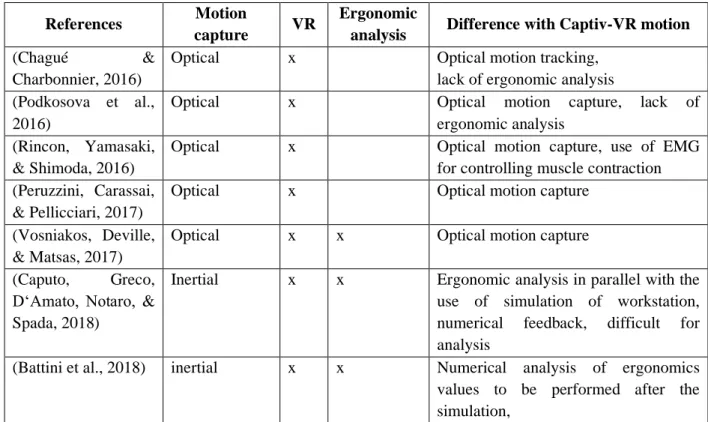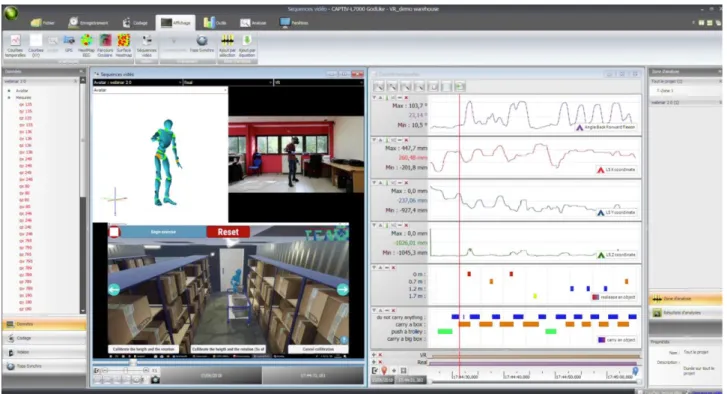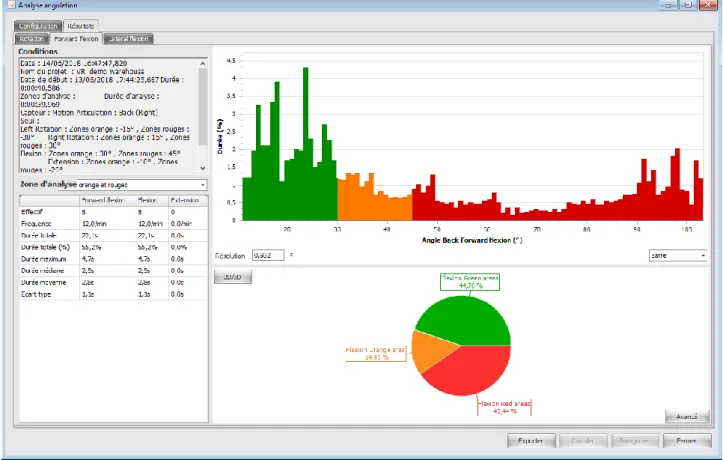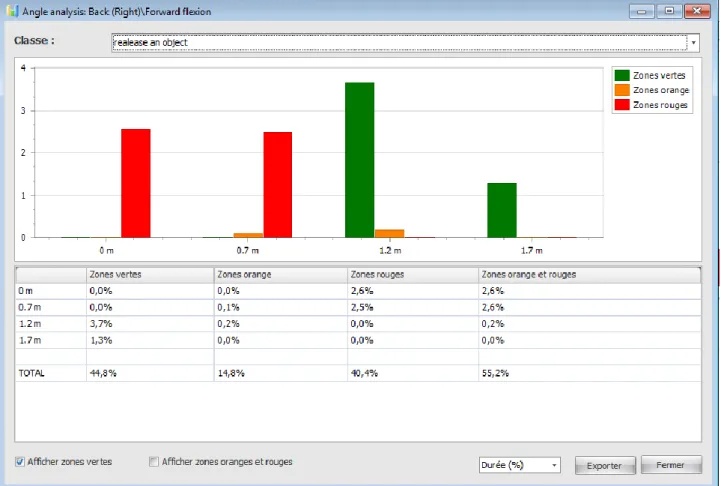HAL Id: hal-02565428
https://hal.univ-lorraine.fr/hal-02565428
Submitted on 24 Jun 2020HAL is a multi-disciplinary open access archive for the deposit and dissemination of sci-entific research documents, whether they are pub-lished or not. The documents may come from teaching and research institutions in France or abroad, or from public or private research centers.
L’archive ouverte pluridisciplinaire HAL, est destinée au dépôt et à la diffusion de documents scientifiques de niveau recherche, publiés ou non, émanant des établissements d’enseignement et de recherche français ou étrangers, des laboratoires publics ou privés.
Development of an IMU-based ergonomics assessment
tool for virtual reality
Giovanny Arbelaez Garces, Julien Michaux, Mauricio Camargo, Nicolas
Ferveur
To cite this version:
Giovanny Arbelaez Garces, Julien Michaux, Mauricio Camargo, Nicolas Ferveur. Development of an IMU-based ergonomics assessment tool for virtual reality. ConVRgence (VRIC) Virtual Reality International Conference Proceedings, Apr 2020, Laval, France. �10.20870/IJVR.2020..3316�. �hal-02565428�
63
Development
of
an
IMU-based
ergonomics
assessment tool for virtual reality
Giovanny Arbelaez
1, Julien Michaux
1,2, Mauricio Camargo
1, Nicolas Ferveur
21Université de Lorraine, ERPI, EA 3767, F-54000 Nancy, France 2TEA, F-54500 Vandoeuvre-lès-Nancy, France
Corresponding author: Giovanny Arbelaez, arbelaez5@univ-lorraine.fr
Keywords: ergonomics assessment – virtual reality – user eXperience – human factors – industry 4.0
Abstract
Human workers are confronted to an increased level of interaction with machines on work settings and manufacturing environments. The design of adaptative production systems that further enhance human’s physical, sensorial and cognitive capabilities requires a thorough understanding of their capacities and a deep analysis of their interactions. This highlights the need for tools that facilitate the study of human-machine interactions on the early design phases. In this paper, we present the development of a tool for prospective ergonomic assessment in virtual reality environments. The proposed tool is based on inertial motion units for motion capture and builds upon an ergonomic analysis software for activity analysis. A warehouse item storage task analysis is presented to illustrate the use of the tool.
1. Introduction
The Industry 4.0 enabling technologies (e.g. Internet of Things (IoT), Cyber Physical Systems (CPS), data mining and cloud computing) (Hofmann & Rüsch, 2017; Lu, 2017; Oztemel & Gursev, 2020; Zhong, Xu, Klotz, & Newman, 2017) are based on automation and data exchange in manufacturing technologies. These technologies will bring significant improvements in effectiveness and efficiency of the industry (Hofmann & Rüsch, 2017; Lu, 2017), but also provide an increased number of interactions between machines and operators. Authors suggest that this interaction should be characterized by the cooperation of machines with humans in work settings in a more “human-centered automation symbiosis” (Longo, Nicoletti, & Padovano, 2017) where the operator of the skills and capabilities of the operator of the future are nor replace by machines but enhanced and supported by them (Romero, Bernus, Noran, Stahre, & Fast-Berglund, 2016). To support the design of machine interfaces and work settings that enhance and support the human operator we need tools to analyze and measure their interactions. In order to, in a prospective manner, to include this analysis into in the design of the manufacturing systems.
While simulation and virtualization technologies might provide a first part of the answer by allowing to analyze the behavior of the future system (El Saddik, 2018). The second part could be covered by a prospective analysis of human factors during the design phase which might provide ergonomist and designers with information regarding tasks acceptability, long before it moves to the assembly line or workplace.
This highlights the need for a system capable of assessing human factors and ergonomics in virtual environment simulations. Current ergonomic analysis are performed through observations and interviews which could end up in an evaluation that differs from specialist to specialist or in measurement mistakes (Carayon, Xie, & Kianfar, 2014; Khandan, Maghsoudipour, Vosoughi, & Kavousi, 2013). These limitations can be partially avoided with the help of some technologies of Industry 4.0 (e.g. sensors). Indeed, some researchers have proposed a few systems that could respond to this need by allowing to perform prospective ergonomic analysis using motion capture (mocap) systems (Battini et al., 2018). However, most of the existing solutions lack a link with a tool that allow to perform the ergonomic analysis by task. What’s more,
the use of optical-based motion capture solutions seems to be generalized while their use is restricted to a lab setting or dedicated room, limiting the possibility to perform on-site analysis. This is a limit if the intent is to assess the simulated environment and the real environment once the solution is deployed. For these reasons in this paper we propose an inertial motion unit (IMU) based ergonomics assessment tool for virtual reality which allow to perform ergonomic analysis of simulated solutions and facilitate the test on the real environment once the solution is deployed.
The rest of the paper is structured as follow. Section 2 presents a brief review of similar systems. Section 3 presents the development of the proposed system. Section 4 illustrates a use situation of the proposed system by the analysis of a warehouse organization task. Finaly, conclusions and perspectives are presented.
2. Related work
Integrating motion capture systems for ergonomics assessment has attracted attention on researchers due to recent advances on head-mounted displays (HMD) and immersive technologies. (Battini et al., 2018) summarized some of the recent systems for ergonomic analysis and motion capture, table 1 develops on their review and includes the current proposed system (Captiv-VR motion). From table 1 we can observe that the use of optical based systems has been a major trend for ergonomic assessment. However, recent developments show that the use of inertial measurement units seems to be more appropriate for the use on workplace and manufacturing sites given their ability to do real time assessment on-site while avoiding the need of a dedicated motion capture room or laboratory (Peeters, Verwulgen, Garimella, Beyers, & Truijen, 2019). This gives the assessment system the advantage of being able to be used on simulation during the design phase and on the real manufacturing site once it is built.
While optical based motion systems tend to have higher precision, recent research has shown that the performance of IMU can be as good as optical systems. Depending of the activity to be assessed (like in the manufacturing floor) their differences are on acceptable ranges (Peeters et al., 2019).
Additionally, to the motion sensors some of the proposed systems provide the possibility to integrate other biometrical measures (e.g. heart-rate, skin conductance, EMG) that could provide more information about the behavior and state of the human operator while performing a given task (Balters & Steinert, 2017; Battini et al., 2018; Peruzzini, Grandi, & Pellicciari, 2017; Peruzzini, Grandi, Pellicciari, & Campanella, 2019). We can observe that from the existing systems only three facilitate the ergonomic analysis task. However, from those tools only the solution proposed by (Battini et al., 2018) facilitates a time-based analysis of position and joint angles of the operator that performs the task. One useful feature on this type of systems could be the possibility to have those measurement values synthesized by task performed. In order to identify the problematic areas like in a Hierarchical Task Analysis (Brinck, Gergle, & Wood, 2010). This feature is however lacking form the existing solutions.
Table 1: Existing and proposed ergonomic analysis system comparison, based on (Battini et al., 2018)
References Motion
capture VR
Ergonomic
analysis Difference with Captiv-VR motion (Chagué &
Charbonnier, 2016)
Optical x Optical motion tracking,
lack of ergonomic analysis (Podkosova et al.,
2016)
Optical x Optical motion capture, lack of
ergonomic analysis (Rincon, Yamasaki,
& Shimoda, 2016)
Optical x Optical motion capture, use of EMG for controlling muscle contraction (Peruzzini, Carassai,
& Pellicciari, 2017)
Optical x Optical motion capture
(Vosniakos, Deville, & Matsas, 2017)
Optical x x Optical motion capture
(Caputo, Greco, D‘Amato, Notaro, & Spada, 2018)
Inertial x x Ergonomic analysis in parallel with the use of simulation of workstation, numerical feedback, difficult for analysis
(Battini et al., 2018) inertial x x Numerical analysis of ergonomics values to be performed after the simulation,
Even though, there are some existing systems to perform ergonomic analysis of task in simulated and virtual environments. They are missing some important features, there is still a need for a system that facilitates the ergonomic analysis by providing a way to synthesize measured values by task in order to facilitate the identification of problematic areas and that could be used both during the design phase and the deployment phase to compare the performance of the designed solution. For this reason, we propose in the next section such a system.
3. Tool design and development
Through the analysis of existent systems and a need analysis the required useful features to be developed in the tool were defined. Among others we found: Ability to integrate additional biometrical sensors to the motion sensors, integration with virtual environments for simulation, integration of tools to facilitate the ergonomically analysis, facilitate the analysis of the activity at the task level.
3.1. System architecture design
The proposed Captiv-VR motion system was designed with the company TEA based on their ergonomic analysis software Captiv L-7000 (TEA-ergo, France). The proposed system architecture is presented in Figure 1 and its composed by the following elements.
Figure 1: CAPTIV VR system architecture.
3.1.1. Inertial motion capture system
The motion capture is performed through 15 IMU (TEA-ergo) with a sampling frequency of 64 Hz placed around the body and joints. The IMUs has being previously tested for their accuracy against optic-based systems (Peeters et al., 2019). The sensor information is transmitted through RF to a receptor unit (T-REC) that is connected (USB) to the main computer where the VR scene and the Captiv-VR software are running. The IMU information is first received by the Captiv-VR. The data provide by the sensors are the body 3D joint angles, and segment rotations.
3.1.2. HMD device
In this system we used the HTC VIVE system (HTC and Valve corporation) as the head mounted display. The system uses two base stations that emits pulsed IR laser to track the position of the HMD and the two wireless controllers. The positioning system allow the user to move in the 3D environment and interact with its elements. Steam VR running on a windows computer is used to communicate with the device trough a USB connection. The HMD allows the user to “see” the virtual scene proposed. The virtual scene was designed in Unity and it communicates with the Captiv-VR software as will be explained next. 3.1.3. Software components (Captiv-VR and Unity plugin)
Several software components communicate in the system. The IMU data is received by the Captiv-VR software through the connection with the T-REC receiver. The information about joints and angles of the body are sent to a Unity scene to have an animated avatar that corresponds to the body of the user and its movements. The unity scene communicates through a Captiv plugin in Unity with a T-Server (TCP/IP server) that establish the connection with the Captiv-VR software. Besides the graphical content and activities that can be performed in the virtual Unity scene, some other information is shared with the Captiv software. First when the scene is start or stopped the information is synchronized with the Captiv software to record the actions and keep all data synchronized (this allows to perform the time-based analysis later). Second, to allow the ergonomic analysis on a task level it is possible to set-up in the Unity scene a coding scheme of actions performed and send them to the Captiv-VR software. Each time the user starts, and finish a given action on the VR scene it sends that information to the Captiv software. This allows for instance, to synchronize what actions and for how long are performed by the user and to synchronize all the positions, angle information with the action performed.
The main component is the Captiv-VR software where all the data is synch and the analysis are performed. Figure 2 presents the interface of the Captiv-VR software after a test session. In the left pane all the video
sources are displayed, the 3D avatar that was recorded during the session, a synched video (external source) of the participant with the IMUs and the HMD, and a view of the VR scene. The right pane shows the different sensors and their angles, the bottom image shows the different activities and performed and the time the participant is performing them. All the measures are synched so one can play the video and observe exactly what the participant is doing, and the red marker will move (time-based analysis) in synch to show the corresponding measured values (angles, positions, activity).
Figure 2: CAPTIV VR system interface.
4. Experimental use case: logistic warehouse
In order to better explain the interest of such a system we tested a use case scenario. The example developed is the assessment of a warehouse setting where an operator has to place boxes on their corresponding space (shelves). The operator would transport the boxes to be stored with the help of a trolley to move them around the warehouse. Once he has found the corresponding shelf, he would use his hands (trough the VIVE controller) to interact pick-up the box and placed it on the corresponding space. The operator will repeat the procedure until all the boxes on the trolley are stored. The storing places on the shelves have different heights in order to test different positions while placing the items.
From figure 2, we can observe that a first feedback is available for the analysis. Indeed, the joints on the avatar can be setup so to take a color depending if the joint angle is higher than a certain value. In the figure most of the joints are green which indicates to be in a “good” position but the hip is orange which indicates it’s on a zone of attention, a red color indicates that the angle on a joint is in a dangerous value and a position should not be sustained for a long time. These parameters can be setup to correspond to analysis of RULA, OCRA, OWAS and Lifting Index for instance. Figure 3 shows an example of the detailed report for the angle back forward flexion.
Figure 3: Detailed example report.
In the expected features, it was highlighted the interest of having a detailed analysis of angles going high than a certain value on a given task. Take for instance the placing of a box in a shelf. For this task it is interesting to know at what height (or positions on the shelf) the operator is confronted to a “bad” position. In figure 4 for the back/forward flexion we can have a detail of during the entire procedure how many times (or in what frequency) he took the “bad” position (according to the different levels: green, orange, red) and the corresponding heights. Figure 4 shows that in our case the operator took more bad positions (red zone) while placing objects on the tow bottom shelves (0 m and 0.7m). While having a comfortable position (green zone) when the shelves where at its height.
Figure 4: Example analysis by placement height.
5. Conclusion and perspectives
In this short paper, we presented the development of a tool to improve the ergonomics assessment of activities. This tool can improve the design process of workplace or manufacturing setups by facilitating the inclusion and real assessment of human factors with a real assessment of the “future” performed task. For this we used a simulation of the future setup configuration through a virtual reality scene. This assessment facilitates and allows the improvement of the future scenarios by allowing to assess problematic situations during the design process before the job is performed on the real workplace. The use of IMU for motion capture and the use of the Captiv-VR platform allow to perform the same analysis once the workplace will be built.
Furthermore, through the integration of other biometrical measures (such as a heart rate monitor), some indicators of fatigue or stress level can be integrated. Finally, the proposed system is still in development to include new useful features and as such a more detailed experimental testing could be performed.
6. Acknowledgments
Part of this work was founded by the ANR under the joint-research lab program Labcom N-Hum-Inno (ANR 18-LCV3-0007-01).
7. References
Balters, S., & Steinert, M. (2017). Capturing emotion reactivity through physiology measurement as a foundation for affective engineering in engineering design science and engineering practices. Journal of
Intelligent Manufacturing, 28(7), 1585–1607. doi: 10.1007/s10845-015-1145-2
Battini, D., Calzavara, M., Persona, A., Sgarbossa, F., Visentin, V., & Ilenia, Z. (2018). Integrating mocap system and immersive reality for efficient human-centred workstation design. IFAC-PapersOnLine,
51(11), 188–193. doi: 10.1016/j.ifacol.2018.08.256
23–72). Elsevier. doi:10.1016/B978-0-12-375114-0.00005-0
Caputo, F., Greco, A., D‘Amato, E., Notaro, I., & Spada, S. (2018). A Preventive Ergonomic Approach Based on Virtual and Immersive Reality. In R. F. & S. M. (Eds.), Advances in Ergonomics in Design.
AHFE 2017. Advances in Intelligent Systems and Computing (pp. 3–15). Springer, Cham.
doi:10.1007/978-3-319-60582-1_1
Carayon, P., Xie, A., & Kianfar, S. (2014). Human factors and ergonomics as a patient safety practice. BMJ
Quality & Safety, 23(3), 196–205. doi:10.1136/bmjqs-2013-001812
Chagué, S., & Charbonnier, C. (2016). Real virtuality. In Proceedings of the 2016 Virtual Reality
International Conference on - VRIC ’16 (pp. 1–3). New York, New York, USA: ACM Press.
doi:10.1145/2927929.2927945
El Saddik, A. (2018). Digital Twins: The Convergence of Multimedia Technologies. IEEE MultiMedia,
25(2), 87–92. doi:10.1109/MMUL.2018.023121167
Hofmann, E., & Rüsch, M. (2017). Industry 4.0 and the current status as well as future prospects on logistics.
Computers in Industry, 89, 23–34. doi:10.1016/j.compind.2017.04.002
Khandan, M., Maghsoudipour, M., Vosoughi, S., & Kavousi, A. (2013). Safety Climate and Prediction of Ergonomic Behavior. International Journal of Occupational Safety and Ergonomics, 19(4), 523–530. doi:10.1080/10803548.2013.11077018
Longo, F., Nicoletti, L., & Padovano, A. (2017). Smart operators in industry 4.0: A human-centered approach to enhance operators’ capabilities and competencies within the new smart factory context.
Computers and Industrial Engineering, 113, 144–159. doi:10.1016/j.cie.2017.09.016
Lu, Y. (2017). Industry 4.0: A survey on technologies, applications and open research issues. Journal of
Industrial Information Integration, 6, 1–10. doi:10.1016/j.jii.2017.04.005
Oztemel, E., & Gursev, S. (2020). Literature review of Industry 4.0 and related technologies. Journal of
Intelligent Manufacturing, 31(1), 127–182. doi:10.1007/s10845-018-1433-8
Peeters, T., Verwulgen, S., Garimella, R., Beyers, K., & Truijen, S. (2019). Full Body Three Dimensional Joint Angles Validation Using TEA Ergo Inertial Measurement Units. In T. Ahram, W. Karwowski, & R. Taiar (Eds.), International Conference on Human Systems Engineering and Design: Future Trends
and Applications (Vol. 876, pp. 879–884). Cham: Springer International Publishing.
doi:10.1007/978-3-030-02053-8_133
Peruzzini, M., Carassai, S., & Pellicciari, M. (2017). The Benefits of Human-centred Design in Industrial Practices: Re-design of Workstations in Pipe Industry. Procedia Manufacturing, 11, 1247–1254. doi:10.1016/j.promfg.2017.07.251
Peruzzini, M., Grandi, F., & Pellicciari, M. (2017). Benchmarking of Tools for User Experience Analysis in Industry 4.0. Procedia Manufacturing, 11(June), 806–813. doi:10.1016/j.promfg.2017.07.182
Peruzzini, M., Grandi, F., Pellicciari, M., & Campanella, C. E. (2019). User Experience Analysis Based on Physiological Data Monitoring and Mixed Prototyping to Support Human-Centre Product Design. In F. Rebelo & M. M. Soares (Eds.), Advances in Intelligent Systems and Computing (Vol. 777, pp. 401– 412). Cham: Springer International Publishing. doi:10.1007/978-3-319-94706-8_44
Podkosova, I., Vasylevska, K., Schönauer, C., Vonach, E., Fikar, P., Broneder, E., & Kaufmann, H. (2016). ImmersiveDeck: A large-scale wireless VR system for multiple users. In Proceesings of the 9th
Workshop on Software Engineering and Architectures for Realtime Interactive Systems SEARIS 2016.
Greenville, SC, USA.
Rincon, A. L., Yamasaki, H., & Shimoda, S. (2016). Design of a video game for rehabilitation using motion capture, EMG analysis and virtual reality. In 2016 International Conference on Electronics,
Communications and Computers (CONIELECOMP) (pp. 198–204). IEEE.
doi:10.1109/CONIELECOMP.2016.7438575
Romero, D., Bernus, P., Noran, O., Stahre, J., & Fast-Berglund, Å. (2016). The Operator 4.0: Human Cyber-Physical Systems & Adaptive Automation Towards Human-Automation Symbiosis Work
Systems. In IFIP WG 5.7 International Conference on Advances in Production Management Systems,
APMS 2016 (pp. 677–686). Springer, Cham. doi:10.1007/978-3-319-51133-7_80
Vosniakos, G.-C., Deville, J., & Matsas, E. (2017). On Immersive Virtual Environments for Assessing Human-driven Assembly of Large Mechanical Parts. Procedia Manufacturing, 11, 1263–1270. doi:10.1016/j.promfg.2017.07.253
Zhong, R. Y., Xu, X., Klotz, E., & Newman, S. T. (2017). Intelligent Manufacturing in the Context of Industry 4.0: A Review. Engineering, 3(5), 616–630. doi:10.1016/J.ENG.2017.05.015




